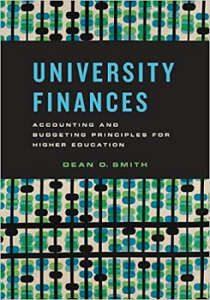Book Review: University Finances

Author: Dr. Dean Smith, Registry Member
Reviewer: Dr. Raj Parikh, Registry Member
University Finances, a book by Dean O. Smith (Johns Hopkins University Press, 2019) presents a comprehensive overview of accounting and finance in higher education institutions. The author begins with “a university is a business (p.1)” – and elaborates on how a university needs to function as a business, explaining the concepts and sources of revenue as well as how to interpret and manage expenses (Chapters 4 and 5). These concepts are particularly useful to academic leaders such as presidents, provosts, deans as well as faculty, who are not familiar with the various sources of revenue available to institutions of higher education. He provides a detailed overview of state appropriations, student financial aid, research grants, land grants, gifts, and revenue from auxiliary enterprises such as housing, bookstore and food service. He continues with a discussion regarding endowments, explaining how “properly invested, an institution’s endowment provides a source of income in perpetuity (p. 82).” A table on page 83 illustrates average endowment payout rates (which supplement other income) which hover around 4% and so make this form of revenue important.
In chapter 5, Smith explains the various types of capital assets and depreciation. Perhaps most useful to senior administrators is the section on how various types of bonds may be used to finance the acquisition of capital assets. The section on budgets is useful to all administrators and describes various budgeting models including centralized versus decentralized, revenue- based vs. responsibility center management models. In times of financial stress, many institutions must make budget cuts and the author discusses several approaches to these cuts that provide sound options and different viewpoints.
In Chapter 7, the author explains the difference between budgets which are forward looking and income statements which are based on actual revenue and expenses and are historical. While most administrators are familiar with many elements of income statements, few understand how pension liabilities, which can be significant, are reported and affect an institution’s solvency. In the same chapter, he explains basic analysis of financial statements, including net tuition and fees contribution ratio. These draw attention to admission policies and retention rates to ensure adequate enrollment to meet expenses. It would have been useful to provide information on the US Department of Education’s financial-responsibility score at this point.
Chapter 8, Grants and Contracts, contains an excellent explanation of sponsored research. The author describes the fundamental legal and accounting differences between grants and contracts and describes USDA capacity grants for land-grant institutions in great detail. Chapter 9 provides details on indirect costs particularly as they apply to sponsored research. These topics will prove particularly useful to administrators in public institutions with significant sponsored research activities.
Chapter 10 discusses how a university may stretch its money and increase its capacity to accomplish its mission using return on investment, insurance, soft-money appointments and external activities by faculty.
Several chapters in this book, particularly those on sponsored research, apply to public and research universities. However, even administrators in private institutions, especially those with grants and contracts, will find these chapters useful.
Members of the Registry Interim are often placed in challenging situations with expectations to obtain results over a short period of time. Those that do not have formal training in accounting and finance will find this book particularly useful – not just to read through but to keep as a handy companion to answer questions that may arise during their appointments. Dean Smith has done a remarkable job pulling together many financial issues affecting higher education institutions, many of which presently face financial stress. I recommend this book highly to all administrators.
HIRE AN INTERIM
Searching for an Interim?
Please contact us for more information.

